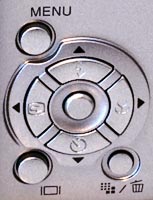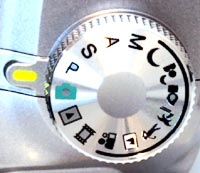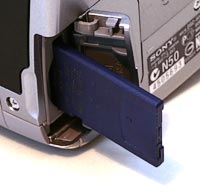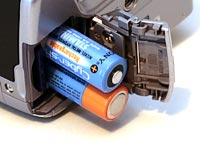Sony Cyber-shot DSC-H1
Review Date: October 31st 2005
|
Ease of Use
When you consider that the Sony Cyber-Shot DSC-H1 has a massive 12x optical zoom lens and large 2.5 inch LCD screen, the relative compactness of the camera is even more surprising (it measures 107.8 (W) x 91.2 (D) x 81.4 (H) mm). The Sony Cyber-Shot DSC-H1 is a stylish and very well-built camera that thankfully doesn't concentrate solely on good looks at the expense of ease of use and functionality. It is surprisingly light at around 440 grams without the battery and memory card fitted, thanks largely to the all-plastic construction, yet it still feels substantial and sturdy in use. The front of the camera is dominated by the that massive lens, which dwarves the handgrip and is the central focus of the entire body. If the appearance of your digital camera is important to you, then you won't be disappointed with the Sony Cyber-Shot DSC-H1. I did find however that both the large 2.5 inch LCD screen is susceptible to fingerprints.
The Sony Cyber-Shot DSC-H1 is comfortable to hold. Your right thumb naturally rests just below the Zoom lever, and Sony have thoughtfully provided a raised groove to prevent your thumb from slipping off the camera. The rubberised handgrip is big enough to hold the camera with two fingers of your right hand whilst operating the shutter button with your index finger, and you can also comfortably hold the camera and take pictures with one hand. The various buttons are a bit plasticky but they are easy to operate and the camera feels well-balanced in your hands. The flash unit automatically opens when you select a Flash mode, quite a nice touch. Overall the Sony Cyber-Shot DSC-H1 is well constructed and designed with no obvious signs of corners being cut.
| Menu / Arrow Pad / Display / Image Size/Delete Buttons | Viewfinder/LCD / Image Stabilisation Buttons |
 |
 |
The Sony Cyber-Shot DSC-H1 has quite a lot of external controls, 17 in total, reflecting the fact that this quite a complicated camera in functionality terms. You can directly access the various flash, macro and timer options by clicking the arrows on the arrow pad. Unfortunately, Sony have chosen to bury some commonly used features, such as ISO speed and White Balance, in the menu system. I would have preferred to see dedicated buttons for these options. All 17 external controls are clearly labeled using industry-standard symbols and terminology. Overall the camera body feels well-designed and not too cluttered, despite the presence of the large 2.5 inch LCD screen. An electronic viewfinder is also included, which is welcome for moments when it is difficult to use the LCD screen i.e. in very bright sunlight. I found it to be too small and quite difficult to use, however, so you will probably find yourself using the LCD screen most of the time.
If you have never used a digital camera before, or you're upgrading from a more basic model, reading the comprehensive and fairly easy-to-follow manual before you start is a good idea. Thankfully Sony have chosen to go against recent trends and provide it in printed format, rather than as a PDF on a CD.
The menu system on the Sony Cyber-Shot DSC-H1 is straight-forward to use and is accessed by a dedicated button next to the LCD screen. It includes most of the camera's main settings, including white balance, exposure compensation and ISO, so you will quickly get used to it! A row of icons along the bottom of the LCD screen represents the various options, and as you move from one to the next the options for that setting pop-up on the screen as a list. Navigating to the Setup option at the end of the row opens a sub-menu containing less used settings, although annoyingly you will find the Red-Eye Reduction option here. Due to the very large and bright LCD screen, the various options are easy to access and use, especially as only a few are shown onscreen at one time.
| Exposure Mode Dial | Zoom Lever |
 |
 |
The Sony Cyber-Shot DSC-H1 offers full photographic control in the form of Shutter-priority, Aperture-priority and Manual exposure modes, which means that you can gradually progress from letting the camera decide everything for you to having complete control over exposure. Very welcome. Changing aperture or shutter speed in the full Manual mode is quite complex at first, however, although it does get easier with practice. You have to press the jog dial until the small yellow triangle at the bottom of the LCD turns yellow, move the dial left or right to choose whether you want to change aperture or shutter speed, press the jog dial again and move it left/right to select the particular aperture/shutter speed. It's not very quick in operation and therefore better suited to slower moving subjects.
One of the main selling points of the Sony Cyber-Shot DSC-H1 is its image stabilisation system, which allows you to take sharp photos at slower shutter speeds than other digital cameras. It works really well - you can see the results for yourself on the Image Quality page. From an ease of use point of view, enabling this feature couldn't be easier - simply press the button with the hand symbol on the rear of the camera. You don't notice that the camera is actually doing anything different when anti-shake is turned on, just that you can use slower shutter speeds than normal and still take sharp photos.
| Memory Card Slot | Battery Compartment |
 |
 |
The start-up time from turning the Sony Cyber-Shot DSC-H1 on to being ready to take a photo is average at around 2 seconds, and it takes about 1.5 seconds to zoom from the widest focal length to the longest, and back again, which isn't too bad at all considering that it has 12x magnification. Focusing is quick in good light and the camera happily achieves focus indoors or in low-light situations. The visibility and refresh rate of the 2.5 inch LCD screen are perfectly acceptable. It takes about 1 second to store an image, allowing you to keep shooting as they are being recorded onto the memory card - there is no LCD blackout between each image. In the normal burst mode the camera takes 9 photos at 0.8 frames per second at 5M Fine quality, not exactly lightning fast. All in all the Sony Cyber-Shot DSC-H1 is above average in terms of operational speed.
Once you have captured a photo, the Sony Cyber-Shot DSC-H1 has a good range of options when it comes to playing, reviewing and managing your images. You can instantly scroll through the images that you have taken, view thumbnails, zoom in and out up to 5x magnification, view slideshows, delete, protect, resize and rotate an image. You can also divide movies, useful if you have run out of space on your memory card but want to keep part of a movie file. The Display button toggles detailed settings information about each picture on and off, such as the aperture, shutter speed and ISO rating, and there is a small histogram available during both shooting and playback which is helpful in evaluating the exposure.
In summary the Sony Cyber-Shot DSC-H1 is a stylish, well built and easy to use digital camera that offers something for the beginner, intermediate and more experienced photographer alike. Only the electronic viewfinder is disappointing.
|
 PhotographyBLOG is a member of the DIWA organisation. Our test results for the Sony Cyber-shot DSC-H1 have been submitted to DIWA for comparison with test results for different samples of the same camera model supplied by other DIWA member sites.
PhotographyBLOG is a member of the DIWA organisation. Our test results for the Sony Cyber-shot DSC-H1 have been submitted to DIWA for comparison with test results for different samples of the same camera model supplied by other DIWA member sites.
